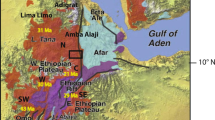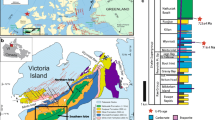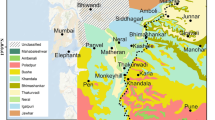Abstract
In the Western Ghats between latitudes 18° 20′ N and 19° 15′ N, 7000 km2 of Deccan Basalt have been mapped with the primary objective of establishing a flow stratigraphy as a guide to the volcanic history of the flood basalts. Using over 70 measured vertical sections, major and trace element analyses of nearly 1200 samples, and rare-earth and87Sr/86Sr determinations for over 60 samples, we divide the basalt into three subgroups and ten formations. In this paper we describe the seven principal formations in the area and the most prominent individual flows.
The Kalsubai Subgroup is formed by the lower five formations, the Jawhar, Igatpuri, Neral, Thakurvadi, and Bhimashankar formations, from botton to top. In these formations amygdaloidal compound flows predominate and have a typically high MgO content, including picrite basalt (> 10% MgO) and picrite (> 18% MgO) with phenocrysts of olivine and clinopyroxene. These flows are separated by others which contain giant plagioclase phenocrysts and have more evolved chamical compositions.
The Lonavala Subgroup overlies the Kalsubai and is composed of two formations, the Khandala and the Bushe. Both are readily recognized in the field and by their chemical compositions.
The Wai Subgroup includes the upper three formations, the Poladpur, the Ambenali, and the Mahabaleshwar. The whole subgroup is composed of simple flows with well-developed flow tops, small phenocrysts of plagioclase, pyroxene and olivine, and relatively evolved bulk compositions.
Distribution and variation in thickness of the straitigraphic units within the Western Ghats provide a first comprehensive view of the development of the Deccan volcanic edifice. The persistent southerly dip and gentle southerly plunging anticlinal form of the flows, the lensoid shape of many of the formations, and nearly randomly oriented feeder-dike system are together interpreted as evidence of a central volcanic edifice formed as the Indian plate drifted northward over a mantle plume or hot spot.
Similar content being viewed by others
References
Agashe LV, Gupte RB (1972) Mode of eruption of Deccan Trap hasalts. Bull Volcanol 35: 591–601
Agrawal JK, Rama FA (1976) Chronology of Mesozoic volcanics of India. Proc Ind Acad Sci 84A: 157–179
Alexander PO (1981) Age and duration of Deccan volcanism. K-Ar evidence. Mem Geol Soc India 3: 224–258
Auden JB (1949) Dykes in western India - a discussion of their relationship with the Deccan Traps. Trans Nat Inst Sci India 3: 123–157
Bloom AL (1978) Geomorphology. Prentice-Hall, New Jersey
Bodas MS, Khadri SFR, Subbarao KV, Hooper PR, Walsh JN (1984) Flow stratigraphy of a part of the western Deccan Basalt province (abs.). 5th Indian Geol Congress, Indian Institute of Technology, Bombay
Cox KG (1983) The Deccan Traps and the Karroo. Stratigraphic implications of possible hot spot origins (abstract). IAVCEI, Hamburg meeting
Cox KG, Hawkesworth CJ (1984) Relative contribution of crust and mantle to flood basalt magmatism, Mahabaleshwar area, Deccan Traps. Phil Trans R Soc Lond A310: 627–641
Cox KG, Hawkesworth CJ (1985) Geochemical stratigraphy of the Deccan Traps at Mahabaleshwar, Western Ghats, India, with implications for open system magmatic processes. J Petrol 26: 355–357
Ghodke SS (1979) Geology of the area around Panvel, Kolaba District, Maharashtra. Ph. D. Thesis, Poona University, Pune
Hooper PR (1981) The role of magnetic polarity and chemical analyses in establishing the stratigraphy, tectonic evolution, and petrogenesis of the Columbia River Basalt. Mem Geol Soc India 3: 362–376
Hooper PR (1982) The Columbia River Basalts. Science 215: 1463–1468
Kaila KL, Murty PRK, Rao VK, Kharetchko GE (1981) Crustal structure from deep seismic soundings along the Koyno II (Kelso-Loni) profile in the Deccan Trap area, India. Tectonophysics 73: 365–384
Kaneoka I (1980)40Ar/13Ar dating on volcanic rocks of the Deccan Traps, India. Earth Planet Sci Lett 46: 233–243
Kaneoka I, Haramura H (1973) K-Ar ages of successive lava flows from the Deccan Traps, India. Earth Planet Sci Lett 8: 229–236
Karmarker BM, Kulkarni SR, Marathe SS, Sowani PV, Peshwa VV (1972) Giant phenocryst basalt in the Deccan Trap. Bull Volcanol 35: 965–974
Krishnamurthy P, Cox KG (1977) Picrite basalts and related lavas from the Deccan Traps of western India. Contrib Mineral Petrol 62: 53–75
Krishnan MS (1953) The structural and tectonic history of India. Mem Geol Surv India 81: 1–109
LaBrecque J, Kent D, Cande S (1977) Revised magnetic polarity time scale for Late Cretaceous and Cenozoic time. Geology 5: 330–335
Mahoney JJ (1984) Isotopic and chemical studies of the Deccan and Rajmahal traps, India: Mantle sources and petrogenesis. Ph. D. Thesis, University of California, San Diego, 1–189
Mahoney J, Macdougall JD, Lugmair GW, Murali AV, Sankar DM, Gopalan K (1982) Origin of the Deccan Trap flows at Mahabaleshwar inferred from Nd and Sr isotopic and chemical evidence. Earth Planet Sci Lett 60: 47–60
Marathe SS, Kulkarui SR, Karmankar BM, and Gupte RB (1981) Variation in the nature of Deccan Trap volcanicity of western Maharashtra in time and space. Mem Geol Soc India 3: 117–127
McElhinny MW (1968) Northward drift of India - Examination of recent paleomagnetic results: Nature 217: 342–344
Merchant H (1977) Structural geology and petrology of the Island of Bombay and surrounding areas. Ph. D. Thesis, Bombay University, Bombay
Najafi SJ, Cox KG, Sukheswala RN (1981) Geology and geochemistry of the basalt flows (Deccan Traps) of the Mahad-Mahabaleshwar section, India. Mem Geol Soc India 3: 300–315
Ness G, Shaul L, Couch R (1980) Marine magnetic anomaly time scales for the Cenozoic and Late Cretaceous. A precise critique and synthesis. Rev Geophys Space Phys 18: 753–770
Ramanan S (1976) Petrology, geochemistry, and paleomagnetism of volcanic rocks north of Vajresurari. M. Sc. Thesis, Indian Institute of Technology, Bombay
Reidel SP (1983) Stratigraphy and petrogenesis of the Grande Ronde Basalt from the deep canyon country of Washington, Oregon, and Idaho: Geol Soc Am Bull 94: 519–542
Sahasrabudhe PW (1963) Paleomagnetism and the geology of the Deccan Traps. Proceedings of the Seminar on Geophysical Investigations in the Peninsular Shield, Osmania University, Hyderabad, India, pp 226–243
Sastri VV (1981) Observations on the age of Deccan Traps and related trap activity in India. Mem Geol Soc India 3: 296–299
Sethna SF (1981) Geology around Bombay - some intriguing problems. Mem Geol Soc India 3: 87–92
Sreenivasarao M, Ramasubbareddy N, Subbarao KV, Prasad CVRK, Radhakrishnamurty C (in press 1986) Chemical and magnetic stratigraphy of parts of Narmada region, Deccan Basalt province. J Geol Soc India
Sukheswala RN (1981) Deccan Basalt volcanism. Mem Geol Soc India 3: 8–18
Swanson DA, Wright TL (1981) The regional approach to studying the Columbia River Basalt. Mem Geol Soc India 3: 58–80
Swanson DA, Wright TL, Hooper PR, Bentley RD (1979) Revisions in stratigraphy nomenclature of the Columbia River Basalt Group. US Geol Surv Bull 1457-G: 1–59
Walker GPL (1972) Compound and simple lava flows and flood basalts. Bull Volcanol 35: 579–590
Wensink H (1973) Newer paleomagnetic results of the Deccan Traps, India. Tectonophysics 17: 41–59
West WD (1981) The duration of Deccan Trap volcanicity. Mem Geol Soc India 3: 277–278
Wood DA, Gibson IL, Thompson RN (1976) Elemental mobility during zeolite facies metamorphism of the Tertiary basalts of eastern Iceland. Contrib Mineral Petrol 55: 241–254
Author information
Authors and Affiliations
Rights and permissions
About this article
Cite this article
Beane, J.E., Turner, C.A., Hooper, P.R. et al. Stratigraphy, composition and form of the Deccan Basalts, Western Ghats, India. Bull Volcanol 48, 61–83 (1986). https://doi.org/10.1007/BF01073513
Received:
Accepted:
Issue Date:
DOI: https://doi.org/10.1007/BF01073513




